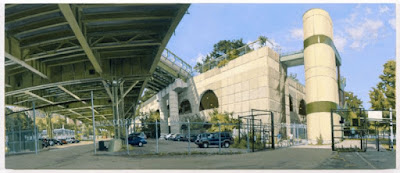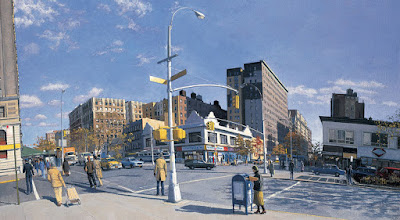| Rackstraw Downes, "At the Confluence of Two Ditches Bordering a Field with Four Radio Towers" (1995), 46 x 48 in. |
 |
| Jean Fouquet, Arrival of Emperor Charles IV... 1455-1460. |
 |
| 360-degree panorama. Photo: Heiwa 4126 |
In many of his paintings, Downes uses a curvilinear perspective that's reminiscent of these photographic approaches. The painting below takes in more than 90 degrees.

Albertian perspective requires holding the head in one line of sight, what Downes calls a "head-in-a-vise" system. Downes' vistas often take in a 180 degree view, which would only be possible if you turned your head from one direction to another.
Such head-turning is in some ways more natural. It's what we do when we look around in a scene. Downes wants to capture this experience "empirically," a word he uses a lot. He's not terribly interested in following a strict geometric system, but would rather interpret the scene each time as he sees it.

Sometimes the resulting paintings have idiosyncratic features. For example, in the scene above, the horizon or eye level is below the center of the image. That would normally require it to be cupped upward in a concave fashion. But instead, Downes sees the horizon as bulging upward convexly. This would only happen in a photo if you pointed a super wide angle lens downward and cropped off the bottom half of the image.
Downes also makes the line of the building at left leaning straight outward, rather than curving back into the scene at the top like a parenthesis, as a normal wide angle perspective would require. These idiosyncrasies of perspective might strike different people in different ways.
To me this one has a queasy, funhouse feeling, and also the sense that the city scene is on the surface of a small spherical planet.

Downes lays out the case for his approach to perspective in an essay called "Turning the Head in Empirical Space," which appears in the back of his book Rackstraw Downes
Another good book is Rackstraw Downes: Onsite Painting, 1972-2008








10 comments:
The convex mirror would be another model for curved depictions of wide views, and I wonder if that's the case for Jean Fouquet (his miniature self portrait looks as if modeled from a convex mirror too). Contrary to what one might assume from his loose brushwork, Van Gogh was very concerned with perspective and used a drawing frame divided with centered vertical and horizontal thread and two diagonal threads that also meet at the center. I have not tried this, but apparently such a pattern avoids the necessity of an eye piece, eliminates distortions at the edges, but results in a curvilinear treatment of perspective. If you look at Van Gogh's Bedroom and Pool Table, you can see the foreground horizontals are angled as if to follow a curve. I like Downes' paintings. I suppose I've come to be more accepting of curvilinear treatments.
As people who have always known photography, curvilinear perspective isn't completely jarring to us.. We are used to seeing and decoding such images and they make a kind of sense to us. Still, I think they don't exactly represent the world as we remember it.. It may be true that objects in our peripheral vision appear to curve, but we don't think of them that way, because we know through other experience that they are straight, and our brain 'corrects' the image accordingly... Thus, the cone of vision that linear perspective adheres to make a lot of sense for portraying the world with the phenomenon of vision as we remember it.
That said, I think Downes and other people who employ curvilinear perspective (like Hockney's photo collages) invite us to see the world not as we remember it, but to kind of enter the mind of the artist and 'look around' with them. They portray the sense of being in a space, rather than an image of the space.. Bah it's a subtle distinction, but tons of fun to consider!
I think some artists have painted on concave surfaces so that when you stand at the right distance, the image sort of envelops you.. Anyone familiar with that illusion? I think Antonio Lopez did something that that...
I haven't read Downes' essay on his depiction of space in his paintings, but I'm very interested now. Thanks, James, for this post.
I do believe that straight lines must appear to curve as they move away from the center of our field of vision, but yes, our brains probably correct those curves, or we simply don't notice them because they are out of focus and the curves must be quite subtle.
As for painting on curved surfaces, Parmigianino did this most famously in his Self-portrait in a Convex Mirror, in which he painted the curving edges he saw in the mirror, and did so on a convex wooden panel. I love this painting, because both the subject and the surface are so perfectly married to the Mannerist aesthetic of distortion. In contemporary art, check out the drawings of the Oakes brothers, Ryan and Trevor, who typically work on concave surfaces.
Like him or not, David Hockney has some interesting thoughts on perspective. I found this video from the Getty rather interesting. The start is about chinese scrolls but later he gets into topics more related to your post.
https://youtu.be/4_lcb28fCz8
Another interesting aproach to a more natural perspective is that of Antonio López in some of his paintings. Here is just an example:
https://s-media-cache-ak0.pinimg.com/originals/fc/93/87/fc938732aa153ec82d44b2d44eeb562f.jpg
Good call Drake– I forgot about that Parmigianino self-portrait! I was unaware of this work until I read an article about it recently where they said he painted it as a calling card for patrons.. My feelings about the Oakes brothers are mixed.. I like the work, but much of the media around them is rather gimmicky and related to contemporary art's inability to take representational/illusionistic work at face value... It can't just be that an artist is probing the act of looking as we've done for hundreds of years; It's a more interesting story if it's young twins and if they work in a terribly elaborate and complicated manner... Gives people something to chat about.
Thanks for the link Chris– I do like some of Hockney (as long as it's not his 'secret knowledge' :) I will take a look when I have a moment
Juan- yes that's what I was thinking of too! I think Antonio lopez also has some early work on curved surfaces as well..
All of the usual curvilinear perspectives stem from anamorphosis - that is, conic projection. This because the main characteristic of (monocular) vision is that points along the same ray from the eye are seen as the same (and, in most circumstances, apparent size of an object is identified with the size of the solid angle subtended by the object).
Because of that, all of these perspectives (including classical) are best understood as a two step process: projection onto a curved surface followed by a flattening of that surface. Of the infinite perspectives thus obtainable, two are "special": classical perspective, because the anamorphic surface is already a plane (hence, no flattening needed) so it is the only one that remains naturally anamorphic, and (360 degree) spherical perspective, since it captures the natural topology of vision, with every line having exactly two vanishing points (solving a perspective is all about solving vanishing points - the points of a line are a subset of the vanishing points of the plane defined by the line and the observer's point).
By the way, the big difference between spherical perspective and the image that you get in a mirrored ball (though they look quite similar https://www.dropbox.com/s/8wvytjjaj4utmio/demo360.jpg?dl=0 ) is precisely that the mirror image is not a *central* perspective, that is, does not come from the flattening of an anamorphosis. You can see this because occlusion is not radial; in a picture reflected in a mirrored ball pairs of points that would be hidden behind each other can be seen as separate.
This non-trivial occlusion makes drawing a sphere reflection very hard unless you calculate it with a computer (or you simply draw by looking at a real mirrored sphere, but that is not an option when drawing from imagination). Spherical perspective, on the other hand, can be drawn by ruler and compass quite simply (I explain how to draw it and compare it with reflections here: https://arxiv.org/abs/1511.02969).
Check out hdrlabs.com for a ton o' theory on this! Spherical panoramas are dynamite.
If you go with this dude's theories of five and six point perspective (aka a mirror ball, and a mirror ball from both sides) and understand your canvas crop from a camera's FOV metaphor (16mm = wide angle, 500 mm = zoom), can you argue 1, 2, and 3 point perspective all are just crops of a 5 point perspective shot, and the crop is so tight the lines falsely LOOK parallel? If our eyes weren't locked at this crop, and instead of turning your head to look up at a tall building it was naturally visible, would we no longer assume that building's lines are parallel as they zoom into the sky?
@ Chris: Thanx for the links to the Hockney lectures.
That ‘Secret Knowledge’ stuff seems pretty straight forward and obvious to me.
I’m not sure I understand the difficulties some people have with Hockney’s thesis about lenses and curved mirrors. Does anyone have a link to a coherent critique? –RQ
Post a Comment